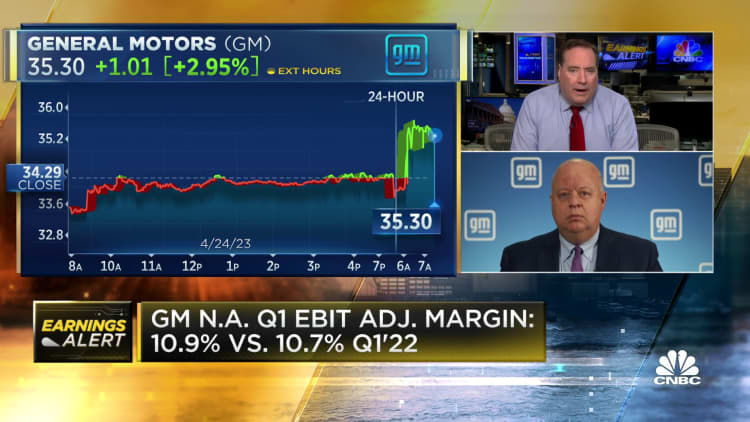
[ad_1]
Mary Barra, chief executive officer of General Motors Co., during the South by Southwest (SXSW) festival in Austin, Texas, US, on Tuesday, March 14, 2023.
Jordan Vonderhaar | Bloomberg | Getty Images
DETROIT – When a company beats Wall Street’s earnings expectations and raises guidance amid recessionary fears and other economic concerns, you would expect the stock to rally.
Look no further to defy that logic than shares of General Motors, which are down nearly 6% this week since the company reported its first-quarter results and raised 2023 guidance Tuesday morning.
Shares closed Wednesday at $32.22 – marking the stock’s lowest closing price since October and 26% off its 52-week high of $43.63 a share. The stock is now down 4.2% for the year.
So, what’s sending the stock lower even as sales are expected to rise and the automaker largely puts years-long supply chain problems in its rearview?
Though GM’s year is off to a good start, the consensus is that the rest of the year is going to prove far more challenging. Wall Street analysts say eroding pricing power, labor concerns and challenges in producing electric vehicles, will make it harder for GM to perform at the profitability levels it has been.
The automaker is painting a rosy picture against the backdrop of a broad normalization in the automotive industry. Record-high vehicle profits and prices, achieved during historically low vehicle inventory levels and resilient consumer demand, are starting to normalize.
“GM continues to do the right things, but we believe cycle normalization and challenges in EV ramp make for a tough investment thesis,” Barclays analyst Dan Levy said in an investor note Wednesday, reaffirming an equal-weight rating but lowering the firm’s price target for the stock by $3 to $42 a share.
GM CFO Paul Jacobson said Tuesday that the company expects flat pricing compared to last year. He said consumers paid an average of $50,263 per vehicle in the U.S. during the quarter, off 1% from a year earlier.
Higher prices are bad news for consumers but great for automakers, as noted by BofA Securities analyst John Murphy in an investor note Wednesday titled, “You hate it, we like it: execution and price drive beat and raise.”

GM’s stock price since Mary Barra became CEO of the automaker on Jan. 15, 2014.
GM upped its full-year adjusted earnings expectations to a range of $11 billion to $13 billion on Tuesday, from a previous range of $10.5 billion to $12.5 billion. But those results represent a decline of between 10% and 24% from the roughly $14.5 billion in adjusted earnings it reported in 2022.
Wells Fargo analyst Colin Langan on Wednesday called GM’s guidance raise “surprising given pricing risks, particularly in China, and rising steel costs.” He singled out the company’s pricing expectations, which he called “bullish,” as a chief concern.
GM has shown restraint in not over-producing this year, helping to keep inventories in line with demand and prop up prices. The company idled pickup truck production at a plant in Indiana around the end of the quarter to keep inventories lower than historical levels.
However, it may need such inventory later this year amid growing concerns around a union strike.
GM is approaching negotiations with the United Auto Workers and Canadian union Unifor, which brings the potential for work stoppage and increased labor costs.
Labor costs don’t typically skyrocket as a result of the periodic negotiations, but a new leadership team is in place at the UAW for the first time in decades and promises more contentious negotiations than recent history. The new union leadership ran on platforms of reforming the organization and standing up to automakers.
“We’re here to come together to ready ourselves for the war against the one and only true enemy: multibillion dollar corporations and employers who refuse to give our members their fair share,” new UAW President Shawn Fain told members during a union convention last month in Detroit. “It’s a new day in the UAW.”
Labor strikes can be costly and deplete vehicle inventories. A 40-day strike against GM during the last round of negotiations four years ago cost GM about $3.6 billion in 2019, including $2.6 billion in earnings before interest and taxes during the fourth quarter.
GM CEO Mary Barra told investors Tuesday the automaker is working to “build a strong relationship with the new leadership” but declined to speculate on the talks and the company’s expectations for the negotiations.
“We’re working to make sure we’re building a strong relationship with the new leadership, getting to know them and making sure we identify what are the challenges of the business and then it becomes working together to solve the issues to get to a good place,” she said.
Shares of GM under Barra, who became CEO in January 2014, are down 19.5% since she took the helm and off 52% from a high of $67.21 achieved during intraday trading on Jan. 5, 2022. Their low under her tenure was $14.33 a share on March 18, 2020.
– CNBC’s Michael Bloom contributed to this report.

[ad_2]
Source link